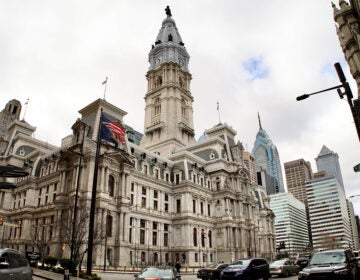How the Pennsylvania Supreme Court race could impact the environment
October 30, 2025
What questions do you have about the 2025 elections? What major issues do you want candidates to address? Let us know.
The retention election for three Pennsylvania Supreme Court justices may be one of the few things drawing some voters to the polls across the state. Voters will cast ballots on whether to award three sitting justices — all Democrats — new 10-year terms on the state’s highest court. The Republican-led movement to urge voters to vote “no” on retention cites their past rulings on pandemic “lockdowns” and voting laws. But the high stakes court race could also determine a number of future state constitutional issues surrounding environmental protection.
The current makeup of the court is a Democratic majority of 5-2, although the justices say partisan politics do not influence their decisions. Together, both parties could end up spending upwards of $10 million, a record-breaking amount in an election that Democrats and Republicans typically ignore.
The three justices — Christine Donohue, Kevin Dougherty and David Wecht — were elected in 2015 and all three ran as Democrats. In 2017, Donohue, Dougherty and Wecht weighed in on one of the most pivotal environmental cases to be decided by the state Supreme Court in recent history – Pennsylvania Environmental Defense Foundation v. Commonwealth.
While the focus has been on how a future court could rule on issues like abortion and voting rights, it’s worth taking a look at how these three justices ruled on a landmark environmental case.
A landmark ruling that bolstered environmental protection
Donohue wrote the majority opinion in Pennsylvania Environmental Defense Foundation v. Commonwealth, which established a broad interpretation of the Environmental Rights Amendment to the state constitution, and cemented in place the commonwealth’s role as trustee for public natural resources. The decision followed a ruling in 2013 written by Republican Chief Justice Ron Castille that cited the Environmental Rights Amendment for the first time and was widely viewed as a win for environmental protection and the rights of local municipalities. The Environmental Rights Amendment had been ratified by voters in the state in 1971.
“The Commonwealth (including the Governor and General Assembly) may not approach our public natural resources as a proprietor, and instead must at all times fulfill its role as a trustee,” wrote Donohue.
Justice Dougherty and Wecht, along with Justice Debra Todd, joined the majority opinion. Justice Max Baer, now deceased, filed a concurring opinion on the broad interpretation of the amendment, but dissented on other aspects of the case.
“If you’re concerned about the environment, these are justices that respect the Environmental Rights Amendment, respect environmental law and they’ve written careful opinions,” said John Dernbach, emeritus professor of law and founder of the Environmental Law and Sustainability Center at Widener University Law School.
Robert McKinstry, an attorney who formed the environmental law practice at Ballard Spahr and continues to litigate environmental and climate change law, said the case has had a large impact on subsequent decisions by the Pennsylvania Environmental Hearing Board and the Pennsylvania Public Utility Commission. He pointed to a 2023 decision by the Commonwealth Court, which cited the Environmental Rights Amendment when it overturned the PUC’s decision to greenlight a PECO natural gas facility in a residential area of Marple Township without conducting an environmental review.
“So for most of my career, the Pennsylvania Supreme Court was dreadful,” McKinstry said. “It was basically legally incompetent.”
He said that began to change when former Chief Justice Ron Castille, a Republican, joined the court in 1994.
“The current three judges have really elevated the Supreme Court from what was a dreadful legal analysis to, I think, one of the leading courts, particularly on state constitutional adjudication,” McKinstry said. “The first was giving the Pennsylvania Environmental Rights Amendment a new life.”
Clean Air Council Executive Director Alex Bomstein said the ruling gave “a roadmap” for environmental cases going forward.
“There are cases that go different ways,” Bomstein said. “It’s not all in any one direction, and once you start getting into the details of different cases, you’re going to get a lot of different results, of course,” Bomstein said.
He called the current seven-member court “traditional” in that it follows the rule of law rather than partisan ideology.
Maya van Rossum, who founded the organization Green Amendments for the Generations, has documented about a dozen instances where the Environmental Rights Amendment, also known as Article 1, section 27 of the Pennsylvania Constitution, has led to rulings favorable to environmental protection or the rights of local municipalities.
“We do see at the federal level, just basic environmental protections being stripped away,” Van Rossum said. “Article 1, section 27 is one way that the state can provide a greater level of protection.”
Next big environmental decision for the state Supreme Court
The court heard arguments in May on constitutional challenges to the state’s efforts to cut its greenhouse gas emissions by joining the Regional Greenhouse Gas Initiative — but has yet to issue a ruling.
It’s unclear how the current court could rule on the case. Dernbach, who watched oral arguments, said he has no idea which way they could go.
The only time voters opted to not retain a sitting Pennsylvania Supreme Court justice was in 2005 when voter anger over pay raises ousted Justice Russell Nigro. If voters decide not to retain all of the three justices up for retention, that would leave four justices on the court, two who ran as Democrats and two who ran as Republicans. But their party affiliations don’t necessarily determine how they would rule on the constitutionality of the Regional Greenhouse Gas Initiative or any other environmental case.
While Gov. Josh Shapiro could appoint replacements to serve before the next election, they would need to be approved by the Republican-led Senate. If that process fails, court watchers and the justices themselves said, it could lead to “disarray” and “chaos.”
WHYY is your source for fact-based, in-depth journalism and information. As a nonprofit organization, we rely on financial support from readers like you. Please give today.
Search
RECENT PRESS RELEASES
Related Post








